In 2022, almost 8,000 human smuggling cases were reported just in Canada. This big number shows we need to stop human trafficking now. Knowing how to spot and fight these crimes is key for keeping people safe. Whether it’s for your safety or to help protect others, these tips are vital in fighting human smuggling in Canada.
Understanding Human Smuggling and Its Impact
Human smuggling is a serious problem that affects people and countries deeply. It is different from human trafficking, and knowing this difference helps fight these crimes effectively.
Difference Between Human Smuggling and Trafficking
Human smuggling and trafficking are illegal, but they are not the same. Smuggling is about moving people across borders, usually with their agreement, to avoid migration laws. Trafficking, however, forces people into work or sex against their will, using lies or violence. It’s crucial to understand this to fight these crimes well.
Impact on Victims and Communities
The effects of human smuggling on victims can be life-changing. They might face terrible conditions, exploitation, and serious dangers to their wellbeing. These victims lose their basic rights and suffer mental and physical harm that can last a long time.
Communities suffer too. They see more crime and have to help and include the victims. This causes social and economic issues that need strong solutions.
Recent Trends and Statistics in Canada
Canada has seen more human smuggling lately, a trend that matches what’s happening worldwide. Crime stats show a rise in organized crime’s role in these activities. This calls for stronger actions against smuggling.
Canada’s police are stopping more illegal border crossings now than before. This highlights how important it is to improve border security and work with other countries. Teaching people about these issues is also key to stopping them.
Recognizing the Signs of Human Smuggling
It’s very important to know the signs of human smuggling to fight this crime. Communities can help a lot by noticing and reporting what seems odd. We will look at how to spot these signs and help out in Canada.
Common Indicators and Red Flags
There are clues that can show someone might be smuggled. These include inconsistent stories and no ID. If someone avoids eye contact or is always with another person, it might mean something.
Seeing signs of abuse or bad living conditions can also be a clue. These signs help us see who might need help.
How to Identify Potential Victims
To spot victims, we need to watch closely and understand what they’re going through. They might be scared, anxious, or seem submissive. If they can’t speak freely or don’t know their address, that’s a concern.
Not having their travel documents is another big warning sign. Noticing these small clues can really help in recognizing trafficking.

Role of Communities in Identifying Smuggling Operations
Communities play a key role in stopping human smuggling. By watching carefully and reporting quickly, people can help authorities act fast. It’s vital for people in Canada to know the signs and help protect others.
Local groups and organizations can offer workshops and information. This helps everyone learn how to notice and report human trafficking.
Tips to Prevent Human Smuggling
To stop human smuggling, it’s key to use effective strategies to stop human smuggling. Making people aware and pushing for action is the first step. This helps teach everyone about the risks and signs of human smuggling.
Begin by setting up info sessions in your area. These should teach crime prevention tips and how to safeguard communities from human smugglers. Having police and specialists talk at these events can offer deep insights and improve involvement.

Working with local police is vital too. Good communication with the cops helps report suspicious activity fast. Setting up a neighborhood watch also helps people look out for each other. This way, everyone can work together to stop smugglers.
Here are some strategies to stop human smuggling and make areas safer:
- Talk about what human smuggling is and how to spot it in your community.
- Start or join groups that keep an eye on the neighborhood.
- Talk regularly with police to know the latest threats.
- Help out with or back groups fighting against human smuggling.
Actions like these not only offer crime prevention tips. They also create a group of alert and informed people ready to safeguard communities from human smuggling.
Creating a Safety Plan
Making a good safety plan needs careful thinking and using digital tools. It’s important to know what steps to take and to get help from people you trust. This makes your safety plan better.
Steps to Develop an Effective Safety Plan
Firstly, trust your instincts. If something feels wrong, it probably is. Get away from places that make you uneasy as soon as you can. Here are some important steps for making a safety plan:
- Write down important phone numbers, like emergency services.
- Make copies of important papers, like your ID.
- Keep control of your phone and money.
For more detailed advice, check out the Canadian Human Trafficking Hotline.
Role of Trusted Individuals and Organizations
Getting help from people and groups you trust is key. Set up a secret signal with friends or family, and tell them where you are. Using groups like the Canadian Human Trafficking Hotline can give you expert advice.
“If you are in immediate danger, call 911. For assistance, reach out to the Canadian Human Trafficking Hotline at 1-833-900-1010.”

Technology and Online Safety Measures
Adding digital security to your safety plan helps keep you safe. Be careful on social media, change your passwords often, and think about turning off tracking on your devices. Use public computers if yours is being watched, and always clear your Sent and Trash email folders.
Keeping your online life secure is crucial. Use things like two-step verification and encryption to keep your info safe.
| Actions | Benefits |
|---|---|
| Use safety words | Quickly signal distress |
| Secure documents | Prevent identity theft |
| Regularly change passwords | Enhance digital security |
Protecting Personal Documents and Identification
Today, keeping your documents safe is more important than ever. This helps stop risks linked to human smuggling. Making sure your personal documents are safe can greatly lower the chance of illegal activities.
Importance of Keeping Documents Secure
It’s essential to protect important papers like passports, driver’s licenses, and birth certificates. If these documents get into the wrong hands, they can be used in smuggling operations. You can keep them safe in secure lockboxes, have encrypted digital copies, and update your security regularly to fight new threats.
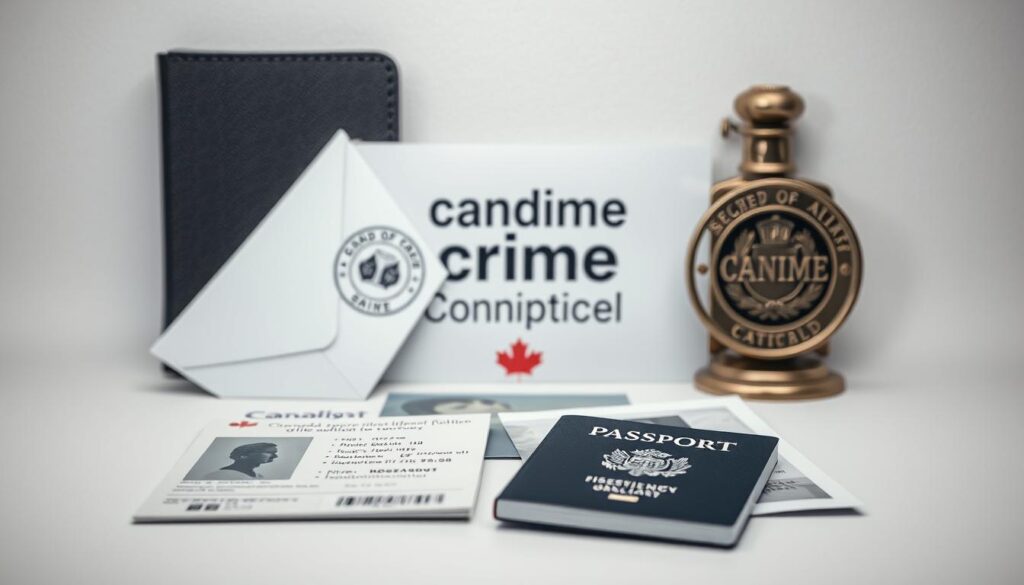
What to Do If Your Documents Are Confiscated
If someone unlawfully takes your documents, you need to act fast to get your identity back. First, tell the local police and any important government offices. It’s also important to tell your bank to stop any unauthorized use of your identity. Getting replacement documents quickly is crucial, and you can usually get temporary ones fast.
Stay alert and consider using document security services to protect yourself from this happening again in the future.
Trusted Contacts and Communication Strategies
Having good communication strategies is very important to keep you and your loved ones safe. Making strong emergency communication plans helps you stay ready for any surprises. This includes knowing how to stay in touch with important people for safety.
Setting Up Safety Words and Emergency Actions
Setting up safety words can really help in emergencies. You and your trusted friends or family pick these special words or phrases together. They signal when you’re in danger or need help right away. Also, make sure you have clear steps to follow for emergencies. For example:
- Know where to go if you’re in danger.
- Keep an emergency kit ready with all you might need.
- Regularly practice these steps with people you trust.
Maintaining Communication with Trusted Individuals
It’s very important to keep in touch with people who can help you. Make sure you always have a way to reach them. Check in often to let them know where you are and if things change. Always keep your emergency communication plan up to date. Make sure everyone knows about any new plans.
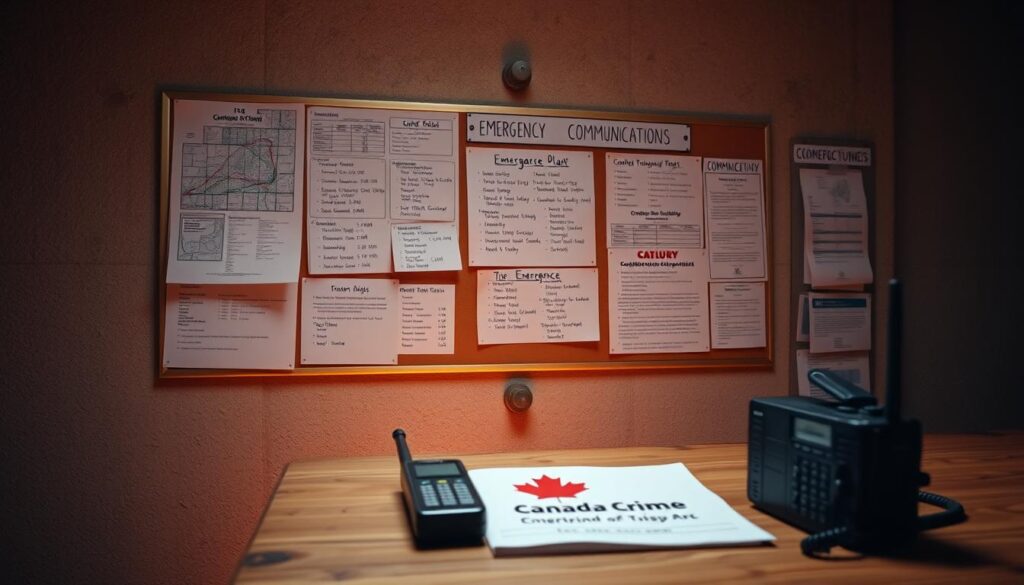
Being prepared and communicating well can lower the dangers of human smuggling. When you’re alert and ready, you and your community stay safer.
Utilizing Technology Safely
Technology surrounds us every day, so it’s critical to know how to use it without risks. By adopting online safety habits, we keep our browsing and social media experiences secure. Let’s explore the best ways to stay safe online.
Safe Internet Browsing and Social Media Practices
For safe web surfing, always visit trustworthy sites. Check for a padlock icon in the address bar to confirm a site’s security. Regularly updating antivirus software and activating a firewall are key steps for safeguarding your online activities.
Being careful on social media means being mindful of the info you post. Don’t share private details like your address or phone number. Tweak your profile’s privacy settings to control who sees your content and only accept friend requests from people you really know.

Creating Secure Email and Online Accounts
Making sure your email and online accounts are secure starts with strong, unique passwords. A good password mixes letters, numbers, and symbols. Change passwords often and stay away from easy-to-guess choices, like your birthday or simple words.
Adding two-factor authentication gives your accounts even better protection. This means you need your password and a special code, usually sent to your phone, to log in. Always be on the lookout for phishing scams and don’t click on strange links or downloads in unexpected emails.
Here’s a quick look at recommended online safety measures:
| Online Safety Measures | Practices |
|---|---|
| Secure Browsing | Use HTTPS, updated antivirus, and firewall protection |
| Safe Social Media Usage | Adjust privacy settings, share limited personal information |
| Secure Email Accounts | Use strong passwords, enable two-factor authentication |
Community Involvement and Support
Being part of your community’s fight against human smuggling is key. When we all work together, we can make a big change. Here are some ways you can help:
Volunteer and Support Local Anti-Smuggling Efforts
One great way to help is by volunteering with groups fighting against smuggling. These organizations need help in many areas. You could spread awareness or help those who have been affected.
When you join community actions, you make these efforts stronger and more effective.
Engaging in Awareness Programs and Events
Local events are a strong way to make people aware of human smuggling. Join workshops and rallies, and tell others about what you learn. By doing this, you not only educate yourself but also build a community that knows how to spot and report dangers.
Role of Schools and Educational Institutions
Schools and colleges have an important part in fighting human smuggling. They can start educational programs on human smuggling. This gives students the tools to stay safe and see risks.
Getting teachers and students to talk about human rights and being careful builds a smart community.
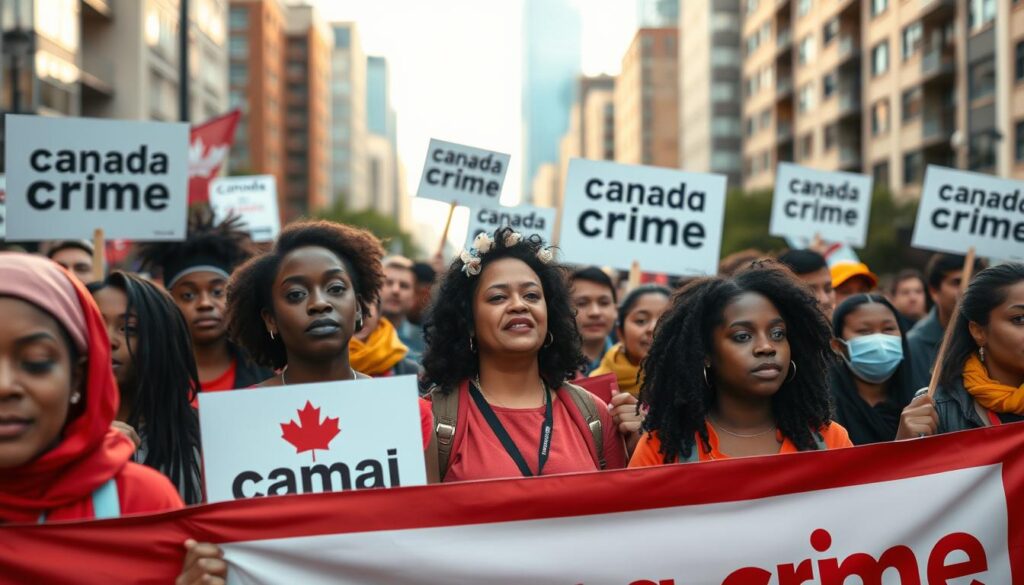
By following these steps, communities can create strong defenses against human smuggling. This makes our environment safer for everyone.
| Method | Details |
|---|---|
| Volunteering | Offer your time and resources to support local initiatives. |
| Awareness Programs | Attend and promote events focused on educating the community. |
| Educational Institutions | Implement programs that teach about human smuggling and its dangers. |
Government and Law Enforcement Resources
Understanding how to reach out to authorities and use government help is key to fight human smuggling in Canada. This part shares info on how law enforcement can assist. It also covers support services for victims and communities.
How to Contact Authorities in Cases of Suspected Smuggling
If you think there’s human smuggling happening, it’s important to report quickly for effective law enforcement help. You should call local police or the RCMP at 911 if it’s an emergency. For situations that aren’t urgent, reach out to the Canada Border Services Agency (CBSA). Your report plays a big role in activating government efforts to prevent crime.
Available Hotlines and Support Services in Canada
Canada has many hotlines and services for fast help and info:
- Canadian Human Trafficking Hotline: 1-833-900-1010, offering 24/7 support for victims of human trafficking and smuggling.
- Crime Stoppers: 1-800-222-8477, for anonymous tips on suspicious activities, helping law enforcement.
- Child Protection Hotlines: Each province provides hotlines for reporting child exploitation and smuggling.
These resources are there to help report human smuggling. They ensure victims get the help and protection they need. Using these government means to prevent crime can greatly lower incidents. It also supports those impacted in Canada.
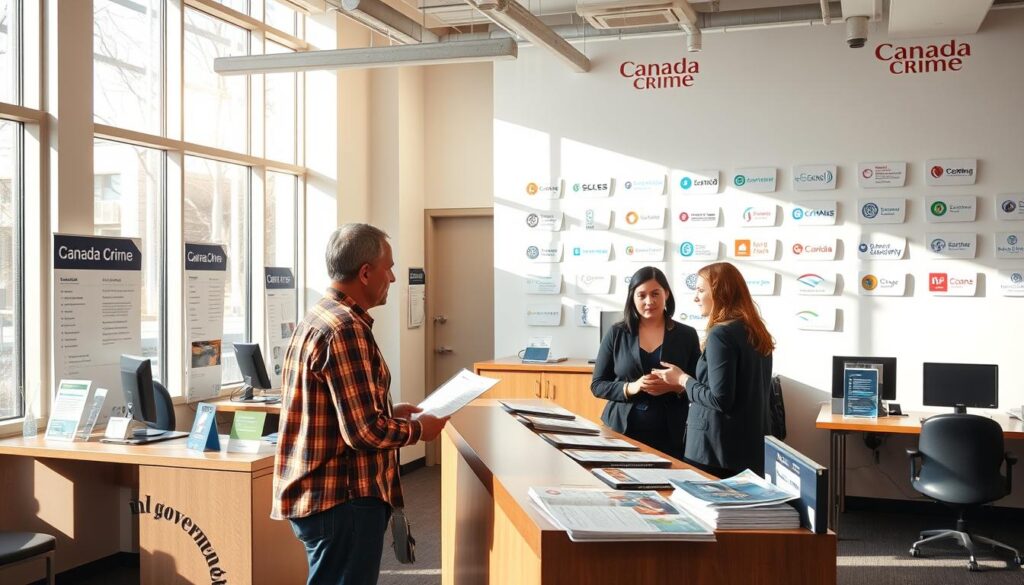
Exit Strategies for Victims
Leaving a human smuggling situation needs careful planning and smart choices. It’s important for victims wanting freedom to know how to safely get out. They must also know where to find quick help for a safe place to stay.
Planning and Executing a Safe Escape
To safely leave, start with a detailed plan. Victims need to know safe spots and be aware of their surroundings. Getting help from trusted people or groups, like local shelters or anti-smuggling teams, is key. Victims must keep escape plans secret from traffickers.
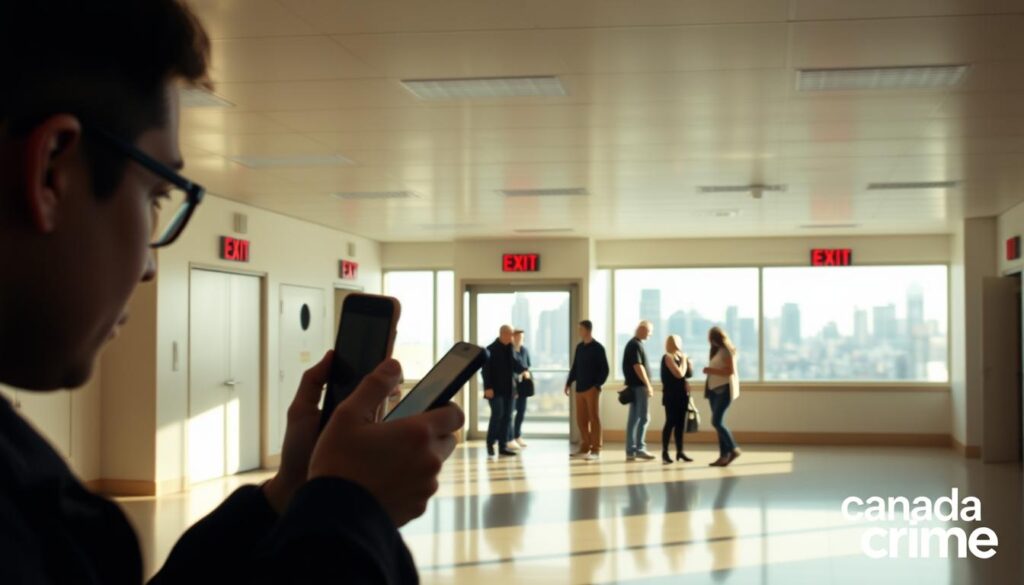
Looking at successful escape stories helps victims see the value of good timing and working together. Having important papers, personal things, and a way to communicate is also very important.
Resources for Urgent Transportation and Shelter
Right after escaping, finding quick help is very important. In Canada, groups like the Canadian Red Cross and police offer emergency help and places to stay. Knowing these groups ahead of time helps a lot.
For immediate aid, the Canadian Human Trafficking Hotline (1-833-900-1010) helps connect victims to safe places. These services help move victims from danger to safety. Community groups like churches and non-profits also help with urgent rescue and support.
In the end, having a well-thought-out plan and knowing where to find help are key to a safe escape. Using emergency resources helps victims get to safety and start anew.
Conclusion
Stopping human smuggling needs everyone’s effort. This includes people, communities, and the authorities. We all must learn about human smuggling and its signs. This knowledge helps protect those who might be at risk. People taking steps to help and spread awareness is also key.
To keep safe, it helps to have a safety plan and keep personal papers secure. Using tech wisely and staying in touch with people you trust can help too. The help from government and police is vital. They offer the support and action needed to fight human smuggling. You can find more data and trends in this informative report.
Beating human smuggling comes down to being educated and staying alert. It’s also about improving safety steps we take. With everyone playing a part, we can make a safer place. This helps lower crime rates and helps victims recover.

